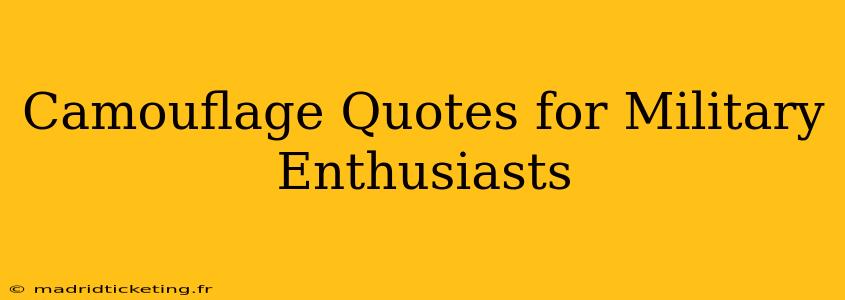Camouflage, more than just a pattern on a uniform, represents a vital military strategy, a powerful symbol of adaptation, and a testament to the ingenuity of those who utilize it. For military enthusiasts, camouflage holds a special significance, representing the blend of bravery, strategy, and stealth that defines modern warfare. This post explores the essence of camouflage through insightful quotes and delves deeper into its multifaceted role.
What is the History of Camouflage?
Camouflage's origins trace back far beyond the modern battlefield. Early forms of camouflage were employed by hunters and warriors alike, using natural materials to blend into their surroundings. However, the systematic development of camouflage as a military science truly emerged during World War I. The need to conceal troops and equipment from aerial observation led to innovative techniques and patterns, forever changing the face of warfare. The evolution of camouflage continues to this day, adapting to new technologies and ever-changing battlefields. We've moved from basic earth tones to incredibly sophisticated digital patterns, reflecting advancements in materials science and our understanding of visual perception.
Why is Camouflage Important in Military Operations?
Camouflage is paramount in military operations for several key reasons. Its primary function is concealment, reducing the enemy's ability to detect and engage friendly forces. This significantly enhances survivability and operational effectiveness. Beyond simply hiding, camouflage acts as a psychological weapon, creating uncertainty and doubt in the minds of the enemy, disrupting their plans, and increasing the potential for surprise. Effective camouflage is an integral part of successful military strategy, a silent guardian ensuring the mission's success.
Famous Camouflage Patterns and Their Histories
Several camouflage patterns have achieved iconic status, each with its own history and associated military operations. For example, the iconic woodland camouflage pattern, with its mix of greens, browns, and tans, has been widely adopted by numerous armies worldwide. Its effectiveness in forested environments has proven itself time and again. Similarly, desert camouflage patterns, designed for arid regions, reflect the unique challenges posed by those environments. Understanding these patterns and their historical contexts provides fascinating insights into military history and technological innovation.
What are the different types of camouflage patterns?
The world of camouflage patterns is remarkably diverse. Different patterns are designed to suit specific environments and terrains. You'll find patterns designed for forests, deserts, jungles, urban areas, and even maritime environments. These patterns aren't just about aesthetics; they are meticulously designed to minimize visual contrast and break up the soldier's outline, making them far less detectable to the naked eye, and even to sophisticated thermal imaging technologies. Understanding the differences between these patterns and the environments they are designed for is key to appreciating their effectiveness.
How does camouflage technology continue to evolve?
Camouflage technology is constantly evolving, driven by advancements in materials science, digital printing, and our understanding of visual perception. We’re now seeing patterns that adapt to different lighting conditions and even those that incorporate infrared and thermal concealment technologies. The goal is not just to blend into the background but to actively negate detection by a range of sensory technologies employed by the opposition. This continuous evolution ensures that militaries remain at the forefront of defensive strategies.
Inspiring Camouflage Quotes:
- "The best camouflage is being where you're not expected." - This quote highlights the element of surprise and the importance of strategic positioning.
- "Camouflage isn't about hiding; it's about becoming invisible." - This emphasizes the deeper meaning of camouflage as a strategy of complete integration with the surroundings.
- "The art of war is based on deception." - While not specifically about camouflage, Sun Tzu's words perfectly encapsulate the strategic essence of camouflage as a tool for deception.
This exploration of camouflage quotes and its vital role in military operations provides a glimpse into the strategic thinking and technological advancements that shape modern warfare. The enduring legacy of camouflage lies not just in its technical aspects but in its symbolic representation of stealth, adaptation, and the unwavering dedication of those who use it.

